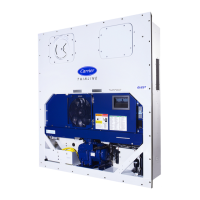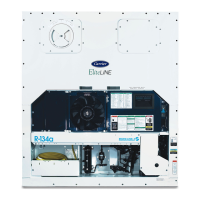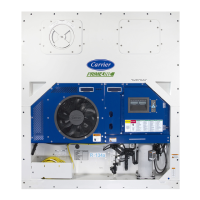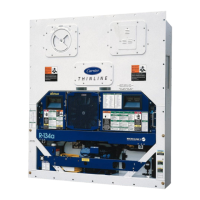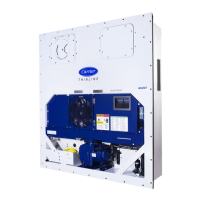76T-305
insulated container (of sufficient size to completely
immerse bulb) with ice cubes or chipped ice, then fill-
ing voids between ice with water and agitating until
mixture reaches 0_C(32_F) measured on a labora-
tory thermometer.
b. Start unit and check sensor reading on the control
panel. The reading should be 0_C(32_F). If the read-
ing is correct, reinstall sensor; if it is not, continue with
the following.
c. Turn unit OFF and disconnect power supply.
d. Refer to section 6.21 and remove controller to gain
access to the sensor plugs.
e. Using the plug connector marked “EC”, that is con-
nected to the back of the controller, locate the sensor
wires (RRS, RTS, SRS, STS, AMBS, DTS, CPDS
OR CPSS as required). Follow those wires to the con-
nector and using the pins of the plug, measure the
resistance. Values are provided in Table 12, page 76.
Table 12. Sensor Temperature/Resistance Chart
Temperature
Centigrade
Temperature
Fahrenheit
Resistance
(Ohms)
RRS, RTS, SRS and STS:
0 32 32,650±91
25 77 10,000±50
AMBS and DTS
0 32
32,650 + 1720
-- 1620
25 77
10,000 + 450
-- 430
Due to the variations and inaccuracies in ohmmeters,
thermometers or other test equipment, a reading
within 2% of the chart value would indicate a good
sensor. If a sensor is defective, the resistance read-
ing will usually be much higher or lower than the resis-
tance values given.
6.22.2 Sensor Replacement
a. Turn unit power OFF and disconnect power supply.
b. For two wire sensors, cut cable 5 cm (2 inches) from
shoulder of defective sensor and discard the defec-
tive sensor only. For three wire sensors cut at 23 cm
(9 inches). Slide the cap and grommet off well
mounted sensor and save for possible reuse. Do not
cut the grommet.
c. If required, prepare the replacement sensor by cut-
ting sensor wire(s) back 40 mm (1-1/2 inch). For three
wire sensors the black wire should be cut at the
middle length and the red/white wire cut to the shorter
length. (See Figure 47)
Sensor
40 mm (1 1/2 inch)
6.3 mm (1/4 inch)
Mounting Stud Type
Sensor
40 mm (1-1/2 inches)
Bulb Type
6.3 mm (1/4 inch)
Figure 47. Sensor Types
d. Prepare the cables by cutting wires to the opposite of
the sensor. (See Figure 48.)
When installing a two wire sensor, cut one (or oppos-
ite color) wire of existing two wire cable 40 mm (1-1/2
inch) shorter than the other wire.
When replacing two single sensors with a combina-
tion (three wire) sensor, the black wires of the cables
should be cut to the same length and the red wire of
one cable cut to the shorter length.
When replacing an original three wire sensor, cut the
black wire to the middle length and the red wire to the
shorter length.
e. If replacing a two wire sensor with a three wire sensor,
do not strip insulation on the red/white wire. Other-
wise, strip back insulation on all wiring 6.3 mm (1/4
inch).
f. Slide a large piece of heat shrink tubing over the
cable, and place small pieces of heat shrink tubing,
one over each wire, before adding crimp fittings as
shown in Figure 48.
g. If required, slide the cap and grommet assembly onto
the replacement sensor. If the replacement sensor is
of a larger diameter than the original, a different grom-
met may be required.
Sensor (Typical)
Cable
Heat Shrink
Tubing
Large Heat Shrink
Tubing
REPLACEMENT 2 WIRE TO 2
WIRE OR 3 WIRE TO 3 WIRE
REPLACEMENT FOR DUAL
SINGLE SENSOR CONFIGURATION
RED
BLACK
RED/WHITE
Figure 48. Sensor and Cable Splice

